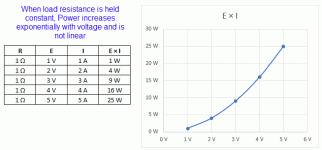Yep. Exactly. You can't increase the voltage without increasing the current into machine. If the power supply is a current limiting type with a 5A limit, you could set it to 24V, but as soon as you powered the unit up, it would drop its output voltage back down to 12V, because that is what it would have to do to keep the current limited to 5A. You can't have both higher voltage and the same current unless the load itself is a constant current drain, and these very simple, inexpensive induction heater circuits are not such circuits.
P=EI
Ohm's Law in its three forms:
E=IR
I=E/R
R=E/I
Suppose you have regulated power whose current limit exceeds anything drawn in this example:
You apply 1V to a resistance 1Ω. Ohm's Law in the second form above says:
I = E/R = 1V/1Ω = 1A
Power dissipated in the load is then:
P = EI = 1V×1A = 1W
You apply 2V to the same load, a resistance of 1Ω.
I = E/R = 2V/1Ω = 2A
Power dissipated in the load is then:
P = EI = 2V×2A = 4W
You apply 3V to the same load, a resistance of 1Ω:
I = E/R = 3V/1Ω = 3A
Power dissipated in the load is then:
P = EI = 3V×3A = 9W.
So, as you increase voltage while keeping the load at a fixed resistance, the power goes up as the square of the change in voltage. That is not linear because power is the product of two factors that are going up at the same time, the same as a square is. Change in power would only be linear if you could increase the resistance in the circuit in proportion to the change in voltage, making one factor that increases power go up while another that decreases power goes up at the same time.
For example: Suppose we go through the same numbers, but with resistance increasing with voltage.
You apply 1V to a resistance 1Ω. Ohm's Law in the second form above says:
I = E/R = 1V/1Ω = 1A
Power dissipated in the load is then:
P = EI = 1V×1A = 1W
You apply 2V to a resistance of 2Ω.
I = E/R = 2V/2Ω = 1A
Power dissipated in the load is then:
P = EI = 2V×1A = 2W
You apply 3V to a resistance of 3Ω:
I = E/R = 3V/3Ω = 1A
Power dissipated in the load is then:
P = EI = 3V×1A = 3W.
You can see we had to increase the resistance of the load to hold the current down to its original value of 1A in order for power to go up directly (a linearl form) with voltage. But there in nothing in an induction heater load to make the resistance go up like that. When the resistance does not go up, use the second form of the power equation to avoid confusion:
P = E²/R
Again, this just substitutes the right side of the second form of Ohm's Law for I in the other form:
P = E×I = E×E/R = E²/R

